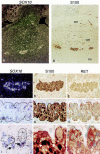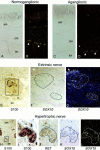SOX10 is abnormally expressed in aganglionic bowel of Hirschsprung's disease infants
- PMID: 11454798
- PMCID: PMC1728391
- DOI: 10.1136/gut.49.2.220
SOX10 is abnormally expressed in aganglionic bowel of Hirschsprung's disease infants
Abstract
Background: The primary pathology of Hirschsprung's disease (HD) is a congenital absence of ganglion cells in the caudal most gut. The spastic aganglionic bowel is often innervated by a network of hypertrophied nerve fibres. Recently, mutations of SOX10 have been identified in patients with HD but only in those with Waardenburg-Shah syndrome.
Aims: To understand the molecular basis for the pathogenesis of HD we intended to determine the specific cell lineages in the enteric nervous system which normally express SOX10 but are affected in disease conditions.
Methods: We studied colon biopsies from 10 non-syndromic HD patients, aged three months to four years, and 10 age matched patients without HD as normal controls. The absence of mutation in the SOX10 gene of HD patients was confirmed by DNA sequencing. Expression and cellular distribution of SOX10 in bowel segments of normal and HD infants were examined by reverse transcription-polymerase chain reaction and in situ hybridisation.
Results: We found that in normal infants and normoganglionic bowel segments of HD patients, SOX10 was expressed in both neurones and glia of the enteric plexuses and in the nerves among the musculature in normal colon. In the aganglionic bowel segments of patients, SOX10 expression was consistently lower and was found to be associated with the hypertrophic nerve trunks in the muscle and extrinsic nerves in the serosa.
Conclusion: We conclude that SOX10 is normally required postnatally in the functional maintenance of the entire enteric nervous system, including neurones and glia. In non-syndromic HD patients who do not have the SOX10 mutation, the SOX10 gene expressed in the sacral region may be involved in the pathogenesis of the abnormal nerve trunks through interaction with other factors.
Figures



References
Publication types
MeSH terms
Substances
LinkOut - more resources
Full Text Sources
